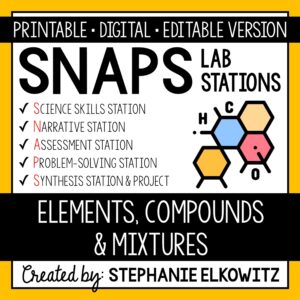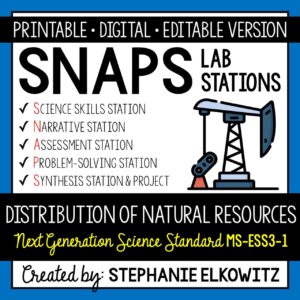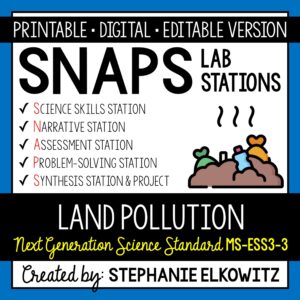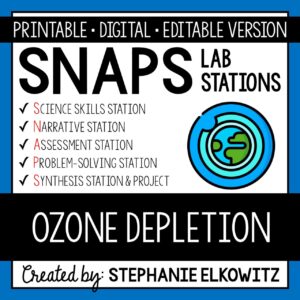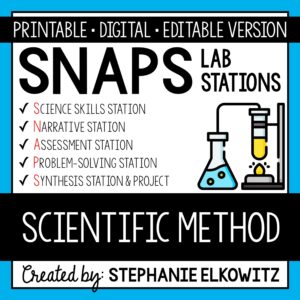Scrutinizing Science Lab
$7.00
An engaging lab activity designed to enhance students’ ability to scrutinize investigations for assumptions, biases and errors.
Description
Scrutinizing Science Lab Preview
SNAPs Lab Stations Activities require students to use science, math, literacy, problem-solving and engineering skills. They are designed to enhance students’ understanding of scientific concepts and help students apply scientific ideas to the real world. Each station activity promotes skills so to develop students into proficient and competent scientific thinkers.
SNAPs lab activities have five components:
• Science Skills Station to develop science skill proficiency
• Narrative Station to build science literacy
• Assessment Station to evaluate learning and understanding
• Problem-Solving Station to foster engineering design
• Synthesis Station and Project to inspire higher-order learning
DIGITAL LABORATORY – DISTANCE LEARNING & DIGITAL CLASSROOMS
• This lab is offered in a digital format to support digital classrooms & distance learning.
• The digital lab activity is designed to work with Google Slides and Microsoft PowerPoint
• The digital lab activity CANNOT be edited. However:
– Students can manipulate text boxes
– Students can create tables, graphs and diagrams
– Students can insert images and drawings
GOOGLE FORM ASSESSMENT STATION
• The assessment station is offered as a self-grading Google Form.
• Questions are all short answer and are 100% editable.
• Suggestions for use are included in the download.
DISTANCE LEARNING COMPATIBILITY
SNAPs lab activities are rated for their ease with distance – independent learning. Refer to the preview for more information about how well this laboratory works in a fully digital classroom and with distance learning.
EDITABLE DOCUMENTS
This download includes an editable word document (docx file) of all lab components:
• Pre-Lab and Post-Lab Activities
• The Lab Overview
• Lab Station Activities and Questions
• Directed Synthesis Project (when applicable)
Important Notes:
• Diagrams, illustrations, tables and graphs essential to lab activities are included
• Illustrative clipart is NOT included
• Editable documents and rubrics are included with the FREE SNAPs Setup Guide
Editable files allow you to:
• Edit the scope of the activities so to suit your students’ needs
• Edit the materials required based on resource availability
• Create single-period “mini-labs” using activities at the individual skills stations
The activities at each station in this lab are detailed below.
Scrutinizing Science Lab Stations Activity Learning Objectives
1. Discuss how controlled variables help produce valid results.
2. Explain how multiple trials and a large sample size reduce error and improve the accuracy of results.
3. Scrutinize investigations for assumptions and biases that influence how an investigation is carried out or how results are interpreted.
4. Analyze and evaluate a scientific investigation for problems that impact the validity.
5. Make suggestions that would improve the validity of scientific investigations.
Science Skills Station
Students will interpret and analyze data from four different science investigations so to examine how uncontrolled variables, a small sample size, a single trial and bias impact the way an investigation is carried out, the data collected from the investigation and/or how the data is interpreted.
Narrative Station
Students will read a passage about factors that improve the reliability of scientific investigation. Students will then watch a video about placebos and how they help improve the validity of scientific investigations.
Assessment Station
At this station, students will answer questions about key terms and ideas relating to scrutinizing science. Students must employ lower, mid and higher order thinking skills to answer these questions.
Problem-Solving Station
Students will act like a peer review and evaluate four different science investigations at this station. Students will identify problems in the investigations and discuss how they impact the validity of the results. Students will make suggestions (solutions) that would improve the way the experiment is carried out, the way the data is collected and/or the way the data is analyzed and interpreted.
Synthesis Station
Students will compose a CER (claim-evidence-reasoning) report to summarize the lab. Students are provided the claim statement and must support the claim with observations, data and other information gathered in the lab. Students will explain how the evidence supports the claim using scientific reasoning.
Synthesis Project
Students will have a choice of 11 projects. Refer to the SNAPs Lab Stations Best Practices and Setup Guide for directions and suggestions on how to conduct the project.
This download includes:
• A pre-lab assignment and post-lab reflection
• Directions and questions for each lab station
• Student recording sheets
• Teacher Key
Additional Materials Required:
1 Computer or tablet
2 Ziploc bags
LINKS TO VIDEOS
This laboratory requires internet to access videos. Videos are hosted on SafeShare.TV so to safely watch and share educational YouTube videos without ads, comments and other distractions. Shortened and full link(s) to SafeShare.TV included. Full link to original YouTube video(s) included.
NEXT GENERATION SCIENCE STANDARDS
The concepts and skills addressed in this product align with the NGSS Nature of Science eight major themes. This product addresses themes that extend the science and engineering practices and cross-cutting concepts across grades 3-5 and 6-8. These practices are outlined in Appendix F and H at http://www.nextgenscience.org/get-to-know.
TERMS OF USE
• All rights reserved by Stephanie Elkowitz.
• This product is to be used by the original purchaser only.
• Intended for classroom and personal use only.
• Copying for more than one teacher, classroom, department, school, or school system is prohibited.
• This product may not be distributed or displayed digitally for public view.
• Failure to comply is a copyright infringement and a violation of the Digital Millennium Copyright Act (DMCA).




